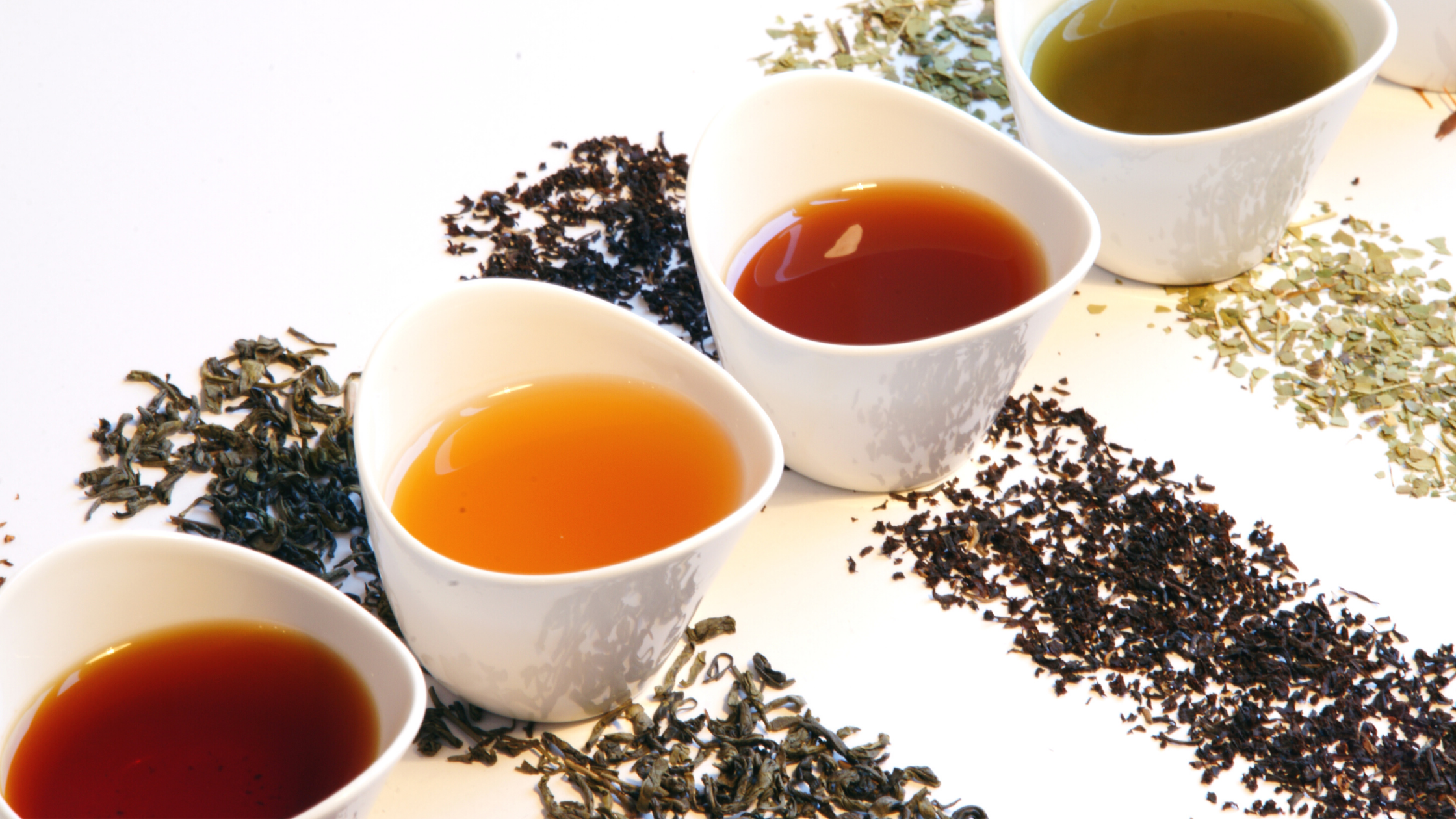Everyone is familiar with black tea and green tea, and most know of oolongs and white teas. Fewer still may be aware of the semi-fermented teas known as hei cha and yellow teas. However, it’s not as widely known what exactly makes a black tea a black tea, a green tea a green tea, and an oolong an oolong. Their tastes and appearances are vastly different, but what causes these differences?
First, it’s important to know that all true tea comes from one species of plant: Camellia sinensis. While there are a few exceptions where closely related species of Camellia other than sinensis can also be used, that’s a topic for another day. Generally, every tea you see is plucked from either Camellia sinensis var. sinensis (small-leaf variety) or Camellia sinensis var. assamica (large-leaf variety). Teas made from other plants are called tisanes or herbal teas and fall outside the six families of true tea.
However, it’s not the species of tea that determines if it is processed as a green, black, oolong, white, yellow, or hei cha. You could pluck the leaf from the same tea bush and process it so that it becomes any one of these six types of tea.
The end results can be so remarkably different that it wasn’t until the mid-nineteenth century that tea importers realized that black and green tea came from the same plant. Batches of black and green tea made from the same tea leaf had to be processed in front of representatives of the tea companies to make them believe, an event described in the journals of Robert Fortune, the notorious Scottish botanist and industrial espionage agent nicknamed “The Tea Thief.”
The processing steps that create the different types of tea were relatively secret at that time, which is why Robert Fortune was sent into closed China after the Opium Wars to discover the secrets of growing and processing tea so that tea plantations in India could be created to compete with the Chinese. Even now, exact processing methods for certain specialty teas are kept as industry secrets by their manufacturers, but most tea processing methods are thoroughly well known.
Green Teas
Although there are many kinds of green teas, they all have one thing in common: they are green. From matcha to dragonwell, sencha to biluochun, they have all been processed with what is known as a “killgreen” step.

This is simply the application of heat while the leaf is still fresh, breaking down any enzymes that would cause oxidation in the leaf. Think of a sliced apple beginning to brown. It has enzymes that begin oxidation when exposed to air. Likewise, a tea leaf with the stem broken off will begin to darken as the enzymes in its cells are exposed to oxygen. The killgreen step breaks down the enzymes that cause this, keeping the leaf green.
The heat can be applied in various ways. Sometimes it is dried with hot air, common with delicate Chinese greens like bilochun. Sometimes it is steam heat, as is done with Japanese sencha. Sometimes the heat comes from dry frying inside a large wok, as is done with traditional dragonwell, giving it the iconic flat leaf shape. After the heat stops the oxidation process, the leaf is then dried to preserve it for storage and shipping.
Black Teas
Black teas are processed with the exact opposite intention. Black teas are nearly fully oxidized, so no killgreen step is done at all. Heat is only applied at the final drying stage, well after the leaf has darkened through oxidation.
Oolong Teas
At the risk of oversimplifying a complex topic, oolong tea is essentially anything between a green and a black tea, and is partially oxidized. There is a killgreen step applied, but only after oxidation has begun. It might be oxidized so little that it looks almost exactly like a green tea—Taiwanese bao zhong oolong is typically so green that some people classify it that way. Other oolongs are oxidized so thoroughly that they might resemble nuggets of charcoal, such as hei oolong (dark oolong).
However, oolongs are not just about partial oxidation. They are considered perhaps the most nuanced and difficult to create types of tea, and their character is the product of more than partial oxidation.

Key to most oolong production is a series of steps that involve intentional damage to the leaf to encourage uneven oxidization. Many types of rolled oolongs are placed in large cylindrical tumblers in which they are rolled until the leaf edges have some crushed bruising. These edges will begin to redden with oxidization earlier than the body of the leaf, creating unique and subtle flavors.
You will see these reddened edges on many whole leaf oolongs where they wanted the blend of flavors. In other cases of high-end oolongs the edges may have been torn off by hand to remove the reddened bits and deliberately create a very refined single flavor profile. There is so much variation in how oolongs can be processed that this family of tea has perhaps more variety than any other type of tea.
White Teas
White tea is often described as “the least processed of all teas.” That is true to some degree. White tea is generally tea leaf that has been dried without a killgreen step but also without extended oxidization. It is just tea leaf that has been withered for a short time to allow extra moisture to evaporate (a step common to almost all tea types) and then dried.
Without a killgreen step though, why doesn’t it oxidize into a black tea? White tea is usually kept whole and intact to minimize oxidization while it dries, but in fact many white teas have quite a few darker leaves from oxidization. The majority of white teas were originally laid out on mats to dry in the sun, but now they are typically dried in warm (but not baking) airflow machines.

There is one variety of white tea called yue guang bai, which means “moonlight white.” (Moonlight Jasmine) Yue guang bai was dried at night, supposedly under the moonlight, rather than sun-dried; these days it is made in airflow machines but using cool air. Using cooler air to dry the tea makes the leaf of yue guang bai either very dark and black or starkly white, creating a contrast in leaf color unique to this white tea.
Also worth mentioning is silver needle white tea. This tea is made exclusively of young leaf buds that are covered in spring fuzz. When dried the resulting furry needles are impressive both dry and as they steep, and as the spring fuzz infuses into the water it can create a sparkling effect unique to this tea.
Yellow Tea
Yellow tea is a rare oddity. It has never been common, and although it has experienced a resurgence of interest in recent years there is still not enough demand for it to make the difficult processing steps very profitable. It is rare enough that even among diehard tea enthusiasts there is much misunderstanding about what defines a yellow tea and how it is processed.
The most famous yellow tea is Junshan Yinzhen (Jun Mountain Needle), grown only on Junshan Island in DongTing lake in Hunan, China. It look similar to silver needle in shape but has a very dark green color. In fact, yellow teas are much like green teas and are processed similarly, just with a few additional steps. After the initial killgreen step yellow teas are re-moistened and go through a wrapping step where the leaf is kept moist in paper or cloth for a few hours or days. The leaf is then re-dried, but the character has changed enough that it is distinct from a green tea. The moistening and wrapping stages are very tricky to do without ruining the tea leaf or encouraging the growth of mold, and requires masterful judgement during processing. It commands a high price for good reason.
Dark Tea / Pu-erh Tea
The sixth and last family of true tea is hei cha, which simply means “dark tea” and refers to all types of semi-fermented tea. Many might disagree and say that pu-erh is the sixth category of tea. Pu-erh is the most common member of the hei cha family, and perhaps ninety percent of all hei cha on the market is pu-erh tea. However other semi-fermented teas can be found throughout China and elsewhere in the world. In addition to pu-erh there are the tian jian of Hunan, the liu bao of Guangxi, the liu an of Anhui, and many others. Even Japan produces a few types of semi-fermented tea.
So what do we mean by semi-fermented tea? It’s a bit of a misnomer, but a useful one. It’s not strictly speaking fermentation as there are no sugars processing into alcohols. However these teas do have microbial life, both bacteria and fungi, that transform these teas over time. Much like fine wine these teas can improve with age, and become more valuable. A pu-erh cake from the 1950’s often sells for $30,000 - $40,000, sometimes much more for a particularly rare cake of tea.

The process to create hei cha generally falls into one of two categories: sheng (raw), or shou (ripe).
The raw hei chas are processed much like a green or white tea with minimal processing, and then compressed into any number of shapes like round cakes, flat bricks, bowls, or pressed into bamboo baskets. They are usually steamed slightly before pressing to allow the shape to form without too much breakage of the leaf, but this also serves to create a hospitable environment for the tea’s microbiome.
The hei cha is then stored where it is exposed to air, allowing oxygen and humidity to access the tea and continue to feed the microbes. Eventually the activity of the bacteria and fungi gently transform the tea into something completely different, changing green and bitter tastes into woody and complex tangy notes, smoothing the mouthfeel, and some say enhancing the cha qi, or tea energy.
Ripe hei cha go through wo dui, a wet piling process or similar method. In this method the microbial transformation is accelerated by adding moisture, heat, and an enclosed environment. Ripe pu-erh is made by heaping tea leaf on a clean factory floor surface, wet down, and then covered with a heavy tarp. Ripe liu bao is placed wet in wooden crates or even small wooden shacks and left in the sun. The tea is then left to process for about six weeks, heating itself up as the leaf breaks down and the microbes do their thing.
Essentially it is very much like carefully controlled composting, but semi-fermented sounds much more appealing and understandably is the term commonly preferred! Once the wet piling process is complete the tea leaf is pressed into cakes or bricks, or left loose before a drying step makes the tea ready for package and sale.
With many hundreds of different styles of tea in China alone we could go on forever describing different specialty teas and how they are processed. In the end though, all true teas can be said to belong to one of these six tea families, and all start with leaf from a Camellia.









Interesting article! Love teas all types&flavors!
Leave a comment